
20 Austro-Hungarian coronas (1892-1914) are a series of coins which were issued due to the monetary reform (the coronas replaced the guilder) and participated in the formation of the gold standard. Together with other denominations, 20 gold Austro-Hungarian coronas became a symbol of economic growth and confidence in the national currency.
Introduction of the coins into circulation
Starting in 1873, the Austro-Hungarian Empire had been suffering from a severe financial crisis for five years. As a result, the budget deficit increased up to 25% of the whole national budget. They were only able to overcome this situation by 1881. During the following fifteen years, gold and silver coins were hardly used for trade, but mostly for savings. All payments were done with paper guilders only. But by the year 1889 the budget had been completely stabilized.
Corona was introduced as a new currency on the 2nd of August. During the monetary reform the gold standard was established (1 kg of gold = 3,280 coronas). Also, gold coins in denominations of 10, 20 and 100 were issued. Due to the economic stability that followed the reform, corona became a trustworthy currency and remained in that state up to the time when World War I started.
Withdrawal of the gold coins from the circulation
The first one to withdraw the corona was Montenegro, introducing a currency of its own in 1906. Shortly after that, another economic crisis hit. It started with the beginning of World War I and finished with the decay of the empire. Before the 1st of August 1914, gold, which was 75%, at the moment of the decay, decreased to 1%. The Austro-Hungarian bank that was ruled by both Austria and Hungary was issuing coronas during the war. But the bank had violated the agreements with the authorities of the countries and lost their trust completely. By 1919 they had switched to using their own currencies.
20 coronas golden coins existed after the 1892 monetary reform. They were circulating by 1918 when Austria became a republic.
Types of Austro-Hungarian 20 coronas coin
The 20 coronas gold coins have the equivalent of 21.6 carats of gold. They have the same technical parameters, but they are different in design, have different text and language. Because of the fact that the empire was bilingual, two types of coins were minted in two different mints in Austria (Cisleithania) and Hungary (Transleithania).
Austrian type
Year of minting: 1894 (minting period 1892-1905)
- Metal: gold/copper (900/100).
- Weight (g): 6.7751 g.
- Diameter (mm): 21 mm.
- Thickness: 1.4 mm.
- Edge: VIRIBVS VNITIS (Lat. – «By united efforts»).
- Obverse: There’s a portrait of Emperor Franz Joseph I in the center of the coin. The back of his head is decorated with a laurel wreath. There’s an engraving around it: «FRANC*IOS*I*D*G*IMP*AVSTR*REX BOH*GAL*ILL*ETC*ET AP*REX HVNG».
- Reverse: In the center of the coin there is a double headed eagle with the Austrian Empire Coat of Arms and royal symbols of power – the crown, sword, scepter and orb. The imperial eagle is surrounded by the words: «XX CORONA MD CC CX CV» and «20 1894 Cor. » at the bottom.
- Place of minting: Austrian mint in Vienna.
20 coronas 1894 GoldAdvert catalog.
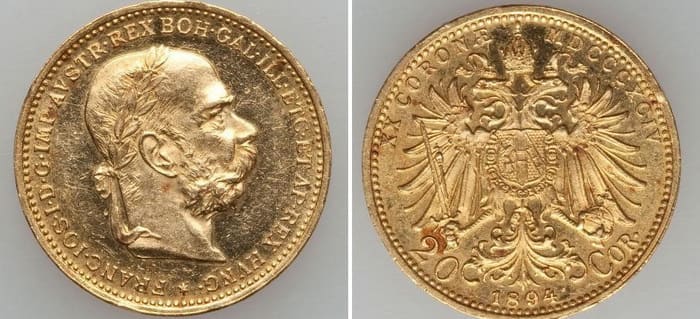
Year of minting: 1908
- Metal: gold/copper (900/100)
- Weight (g): 6.7751 g
- Diameter (mm): 21mm
- Thickness: 1.4 mm
- Edge: VIRIBVS VNITIS (Lat. – «By united efforts»)
- Obverse: There’s a portrait of Emperor Franz Joseph I without the wreath in the centre of the coin. There’s an engraving around it: «FRANC*IOS*I*D*G*IMP*AVSTR*REX BOH*GAL*ILL*ETC*ET AP*REX HVNG»
- Reverse: In the center of the coin there is a double headed eagle with the Austrian Empire Coat of Arms and royal symbols of power – the crown, sword, scepter and orb. Around it there’s an inscription «DVODECIM LVSTRIS GLORIOSE PERACTIS». There’s also an inscription «1848 1908» right above the eagle and «20 CORONE» at the bottom of the coin
- Place of minting: Austrian mint in Vienna
20 coronas 1908 GoldAdvert catalog.
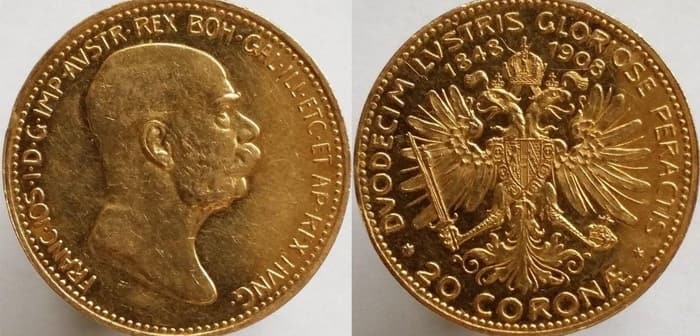
Year of minting: 1909
- Metal: gold/copper (900/100).
- Weight (g): 6.7751 g.
- Diameter (mm): 21 mm.
- Thickness: 1.4 mm.
- Edge: VIRIBVS VNITIS (Lat. – «By united efforts»).
- Obverse: There’s a portrait of Emperor Franz Joseph I without the wreath in the centre of the coin. There’s an engraving around it: «FRANC*IOS*I*D*G*IMP*AVSTR*REX BOH*GAL*ILL*ETC*ET AP*REX HVNG».
- Reverse: In the center of the coin there is a double headed eagle with the Austrian Empire Coat of Arms and royal symbols of power – the crown, sword, scepter and orb. The inscription «XX CORONE MDCCCCIX» surrounds the eagle at the top, and «20 1909 Cor. » at the bottom.
- Place of minting: Austrian mint in Vienna.
20 coronas 1909 GoldAdvert catalog.
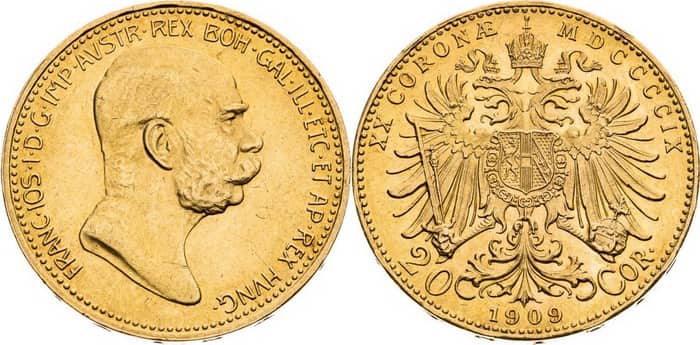
Year of minting: 1914
- Metal:gold/copper (900/100).
- Weight (g): 6.7751 g.
- Diameter (mm): 21 mm.
- Thickness: 1.4 mm.
- Edge: VIRIBVS VNITIS (Lat. – «By united efforts»).
- Obverse: There’s a portrait of Emperor Franz Joseph I without the wreath in the centre of the coin. There’s an engraving around it: «FRANC*IOS*I*D*G*IMP*AVSTR*REX BOH*GAL*ILL*ETC*ET AP*REX HVNG».
- Reverse: In the center of the coin there is a double headed eagle with the Austrian Empire Coat of Arms and royal symbols of power – the crown, sword, scepter and orb. The inscription «XX CORONE MDCCCCXIV» surrounds the eagle at the top and «20 1914 Cor. » at the bottom.
- Place of minting: Austrian mint in Vienna.
20 coronas 1914 GoldAdvert catalog.
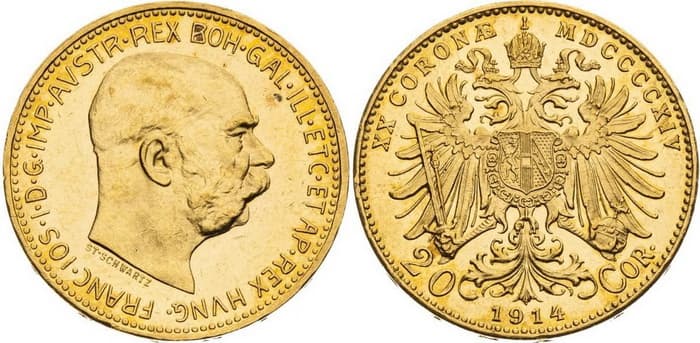
Hungarian type
Year of minting: 1892. (Minting period 1892-1913)
- Metal: gold/copper (900/100).
- Weight (g): 6.7751 g.
- Diameter (mm): 21 mm.
- Thickness: 1.4 mm.
- Edge: BIZALMAM AZ ŐSI ERÉNYBEN (Hung. – «I believe in an ancient power»).
- Obverse: In the center of the coin there’s a picture of Emperor Franz Joseph I in full height, wearing a long cloak. He holds the symbols of royal power: the sword on his belt, scepter and orb in his hands and the crown on his head. There’s an engraving «FERENCZ JOZSEF I*K*A*CS*ES M*H*S*D*O*AP*KIR» around him and «1892» at the bottom.
- Reverse: Hungarian Coat of Arms is engraved in the center of the coin. There are angels on both sides of it. The inscription «MAGYAR KIRALYSAG» stands in a circle at the top and «20 KORONA» at the bottom.
- The place of minting: Kremnica Mint (on the reverse under the Coat of Arms «KB» – is the short name of a city Kormocbanya).
20 coronas 1892 in GoldAdvert catalog.

Year of minting: 1908. (Minting period 1892-1913)
- Metal: gold/copper (900/100).
- Weight (g): 6.7751 g.
- Diameter (mm): 21 mm.
- Thickness: 1.4 mm.
- Edge: BIZALMAM AZ ŐSI ERÉNYBEN (Hung. – «I believe in an ancient power»).
- Obverse: In the center of the coin there’s a picture of Emperor Franz Joseph I in full height, wearing a long cloak. He holds the symbols of royal power: the sword on his belt, scepter and orb in his hands and the crown on his head. There’s an engraving «FERENCZ JOZSEF I*K*A*CS*ES M*H*S*D*O*AP*KIR» around him and «1908» at the bottom.
- Reverse: Hungarian Coat of Arms is engraved in the center of the coin. There are angels on both sides of it. The inscription «MAGYAR KIRALYSAG» stands in a circle at the top and «20 KORONA» at the bottom.
- The place of minting: Kremnica Mint (on the reverse under the Coat of Arms «KB» – is the short name of a city Kormocbanya).
20 coronas 1908 Hungarian type in GoldAdvert catalog.

Year of minting: 1914
- Metal: gold/copper (900/100).
- Weight (g): 6.7751 g.
- Diameter (mm): 21 mm.
- Thickness: 1.4 mm.
- Edge: BIZALMAM AZ ŐSI ERÉNYBEN (Hung. – «I believe in an ancient power»).
- Obverse: In the center of the coin there’s a picture of Emperor Franz Joseph I in full height, wearing a long cloak. He holds the symbols of royal power: the sword on his belt, scepter and orb in his hands and the crown on his head. There’s an engraving «FERENCZ JOZSEF I*K*A*CS*ES M*H*S*D*O*AP*KIR» around him and «1908» at the bottom.
- Reverse: Hungarian Coat of Arms is engraved in the center of the coin. There are angels on both sides of it. The inscription «MAGYAR KIRALYSAG» stands in a circle at the top and «20 KORONA» at the bottom.
- The place of minting: Kremnica Mint (on the reverse under the Coat of Arms «KB» – is the short name of a city Kormocbanya).
20 coronas 1914 Hungarian type in GoldAdvert catalog.
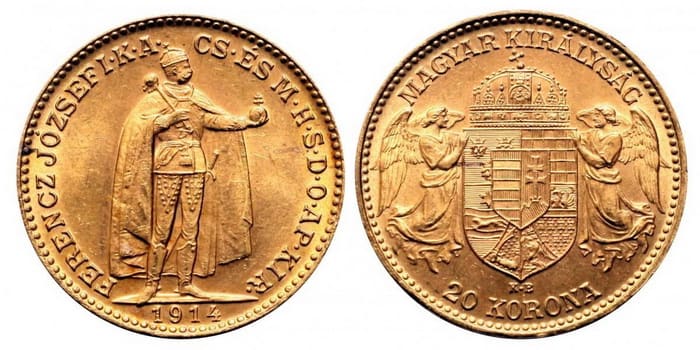
Market price of 20 Austro-Hungarian coronas coins
Prices for this coin vary immensely at different auctions. The price depends on the place of the auction, condition of the coin and the year of minting.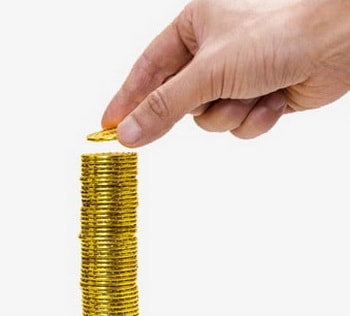
Approximate worth of Austro-Hungarian 20 coronas coins:
- 1892-1905 – 245-450 US dollars;
- 1908 (commemorative coin for the 60th anniversary of Franz Joseph ruling) – 380-570 US dollars;
- 1909-1914 – 570-3800 US dollars.
Approximate cost of Hungarian 20 coronas coins:
- 1892-1914 – 270 US dollars.
Bullion value – 1,256.27 US dollars per ounce.
Historical reference
- Monthly allowance of a lieutenant in the Austro-Hungarian Empire was 230-270 coronas. You could buy 5 mugs of beer for only 1 corona. You could rent a room for a month for 20 coronas, and one bed per night cost only 2 coronas.
- In year 1899 the annual salary of a teacher was almost 1,000 coronas, gendarmerie commandant – 1,400 coronas, gendarme – 800 coronas.
- In 1907 the annual salary of a priest in the Greek-Catholic church was 2,800 coronas.
- In 1911 on the territory of the empire, 1 kilo of veil cost 96-98 hellers (1 corona = 100 hellers), 1 kilo of beef – 86-90 hellers, one sheep – 18 coronas, one goat – exactly 20 coronas .
- In 1911 a peasant would receive 1-1.34 coronas per day, and lumberjack – 1-1.22 coronas.
Official emission of 20 coronas copies in the period of 1892-1914
«MünzeÖsterreich» mint issued copies of 20 gold coronas, so called «Handelsgoldmünzen». They were issued at a little premium over the current market price of the gold. These coins were intended as investment items mostly.
There’s a portrait of Franz Josef I on the obverse (1848-1916), and the reverse is decorated with the Austrian Coat of Arms with the face value of the coin. The edge has the words «VIRIBVS VNITIS» on it. The metal composition is the same as in the original coin – 900/100.
Copies of 10 coronas coin were being minted from 1912 to 1992, copies of 20 coronas coins up until 1989 and copies of 100 coronas up until 1988. Every coin has «1915» on it, marking the year of minting.
The edition of some coins varied a lot from year to year. Emission of 10 coronas copies reached its peak in 1967 – 277,347 coins. In 1984 only 102 coins were issued and sold. In 1954 only six coins of 20 coronas were issued. Between 364 and 730 gold coins had been issued annually during the 14 previous years.
This way the copy of 20 Austro-Hungarian gold coronas became a substitute of a gold bar and a great way to invest your money.
Comments
No commens yet.